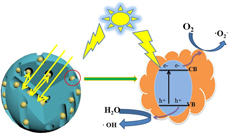Crossref Citations
This article has been cited by the following publications. This list is generated based on data provided by
Crossref.
Zhou, Rong-Hui
Wei, Zhi-He
Li, Yan-Yang
Li, Zhong-Jun
and
Yao, Hong-Chang
2019.
Construction of visible light–responsive Z-scheme CdS/BiOI photocatalyst with enhanced photocatalytic CO2 reduction activity.
Journal of Materials Research,
Vol. 34,
Issue. 23,
p.
3907.
Shen, Qianhong
Wu, Chengyan
You, Zengyu
Huang, Feilong
Sheng, Jiansong
Zhang, Fang
Cheng, Di
and
Yang, Hui
2020.
g-C3N4 nanoparticle@porous g-C3N4 composite photocatalytic materials with significantly enhanced photo-generated carrier separation efficiency.
Journal of Materials Research,
Vol. 35,
Issue. 16,
p.
2148.
Wang, Lele
Chen, Shanshan
Wu, Pengcheng
Wu, Keliang
Wu, Jianning
Meng, Guihua
Hou, Juan
Liu, Zhiyong
and
Guo, Xuhong
2020.
Enhanced optical absorption and pollutant adsorption for photocatalytic performance of three-dimensional porous cellulose aerogel with BiVO4 and PANI.
Journal of Materials Research,
Vol. 35,
Issue. 10,
p.
1316.
Mavengere, Shielah
and
Kim, Jung-Sik
2020.
Photocatalytic Properties of g-C3N4–Supported on the SrAl2O4:Eu,Dy/SiO2.
Coatings,
Vol. 10,
Issue. 10,
p.
917.
Jourshabani, Milad
and
Lee, Byeong-Kyu
2021.
Unmasking the Role of an Amorphous/Amorphous Interface and a Crystalline/Amorphous Interface in the Transition of Charge Carriers on the CN/SiO2/WO3 Photocatalyst.
ACS Applied Materials & Interfaces,
Vol. 13,
Issue. 27,
p.
31785.
Wu, Chenyan
Huang, Feilong
Shen, Qianhong
Yu, LiXin
Zhang, Changteng
Sheng, Jiansong
Cheng, Di
and
Yang, Hui
2021.
Construction of magnetically separable hierarchical Z-scheme NiFe2O4@Bi2Sn2O7 heterojunction with enhanced visible-light photocatalytic activity.
Journal of Materials Research,
Vol. 36,
Issue. 16,
p.
3366.
Chen, Cong
Li, Zhihao
Guo, Yuting
Ling, Liwei
Zheng, Yingping
Ren, Lili
and
Wu, Min
2021.
A Z-scheme iron-based hollow microsphere with enhanced photocatalytic performance for tetracycline degradation.
Journal of Materials Research,
Vol. 36,
Issue. 7,
p.
1600.
Shinde, Preeti S.
Suryawanshi, Pradnya S.
Patil, Kanchan K.
Belekar, Vedika M.
Sankpal, Sandeep A.
Delekar, Sagar D.
and
Jadhav, Sushilkumar A.
2021.
A Brief Overview of Recent Progress in Porous Silica as Catalyst Supports.
Journal of Composites Science,
Vol. 5,
Issue. 3,
p.
75.
Zhang, Yunxiao
Fang, Mengfan
Qian, Xiaorong
Zhang, Li
Gu, Pei
Liu, Yu
and
Yang, Haihua
2021.
Isotype junctioned nanotubes and nanosheets of g-C3N4 for enhanced visible-light driven photocatalytic H2O2 production.
Journal of Materials Research,
Vol. 36,
Issue. 17,
p.
3495.
Wen, Kangxin
Wei, Lianxue
Ren, Zequn
Wang, Bin
and
Lu, Jinfeng
2021.
Enhanced photocatalytic degradation of cationic and anionic dyes by Ag-modified g-C3N4 composite: Insights on different mechanisms under visible light.
Journal of Materials Research,
Vol. 36,
Issue. 7,
p.
1549.
Zhou, Yiming
Elchalakani, Mohamed
Liu, Houfeng
Briseghella, Bruno
and
Sun, Chuanzhi
2022.
Photocatalytic concrete for degrading organic dyes in water.
Environmental Science and Pollution Research,
Vol. 29,
Issue. 26,
p.
39027.
Tarighati Sareshkeh, Abdolreza
Bagheri Some-Saraee, Rahman
Rasoulifard, Mohammad Hossein
Seyed-Dorraji, Mir-Saeed
and
Hosseini, Seyyedeh Fatemeh
2022.
P and C co-modified g-C3N4/SiO2/ZnO Z-scheme based heterogeneous nanocomposite as a highly boosted visible-light-driven photocatalytic system.
Journal of Alloys and Compounds,
Vol. 923,
Issue. ,
p.
166392.
Jia, Ruokun
Yu, Xueli
Yang, Xiaohang
Wang, Xinzhe
Yang, Jiaming
Huo, Xuyang
and
Qi, Qiuju
2022.
Porous graphitic carbon nitride with high concentration of oxygen promotes photocatalytic H2 evolution.
RSC Advances,
Vol. 12,
Issue. 52,
p.
33688.
Wang, Xiaowei
Zhang, Junkai
Wu, Fengmin
Cai, Junqing
Luo, Jie
Zhou, Erpeng
and
Niu, Yongping
2022.
Novel fumed silica/g‐C3N4 composites for highly efficient removal of rhodamine B under visible light emitting diodes light irradiation.
Environmental Progress & Sustainable Energy,
Vol. 41,
Issue. 1,
Yao, Shuhua
Wang, Bo
and
Cao, Xuan
2023.
Multiaperture g-C3N4@SiO2 to activate peroxydisulfate via visible light for efficient Rhodamine B removal.
Environmental Science and Pollution Research,
Vol. 30,
Issue. 30,
p.
75500.
Shoran, Sachin
Sharma, Anshu
and
Chaudhary, Sudesh
2023.
Visible light enhanced photocatalytic degradation of organic pollutants with SiO2/g-C3N4 nanocomposite for environmental applications.
Environmental Science and Pollution Research,
Vol. 30,
Issue. 44,
p.
98732.
Bauri, Jayanta
and
Choudhary, Ram Bilash
2023.
FRET mechanism to enhance the quantum yield of the PCz/gC3N4 nanocomposite, an emissive material for OLED applications.
Physical Chemistry Chemical Physics,
Vol. 25,
Issue. 33,
p.
22195.
Xu, Jianxin
Fan, Hang
Du, Delei
Li, Dongming
and
Chen, Bingzhi
2023.
Light-transmitting AlON carrier with enhanced photocatalytic degradation performance.
Ceramics International,
Vol. 49,
Issue. 15,
p.
24762.
Bauri, Jayanta
and
Choudhary, Ram Bilash
2023.
Thermal and electronic states of exfoliated gC3N4-based nanocomposite with ZrO2 nanoparticles as a robust emissive layer.
Materials Science in Semiconductor Processing,
Vol. 154,
Issue. ,
p.
107205.
Lebedev, М. D.
Goncharenko, A. A.
Skvortsov, I. A.
Kuzmikov, M. S.
and
Vashurin, A. S.
2024.
Preparation of New Hybrid Materials SiO2@Melamine-Cyanurate as Precursors of Graphite-Like Carbon Nitride.
Žurnal neorganičeskoj himii,
Vol. 69,
Issue. 4,
p.
480.



